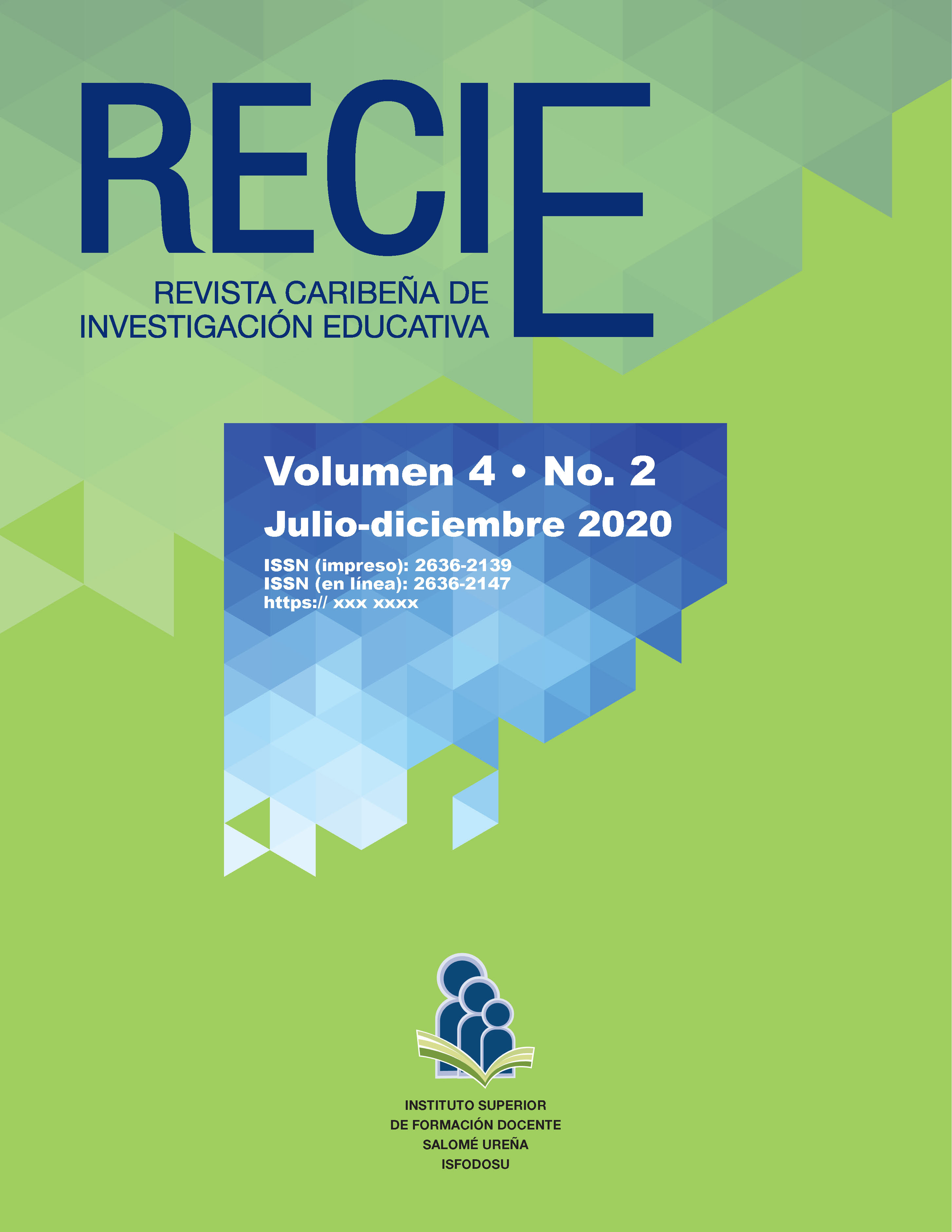Transitioning to Communicative Activities in Teaching English as a Foreign Language in the Dominican Republic
Authors
Alberto Martínez-Gómez
Universidad Tecnológica de Santiago
[email protected] https://orcid.org/0000-0003-0196-1017Detalles
Published
Abstract
In the last decade, the Communicative Approach has taken an important position within the English language teaching world. Many countries have abandoned their traditional teaching methods to implement this approach. The objectives of this research were to analyze the transitioning to communicative activities in Teaching English as a foreign language in the Dominican Republic, to identify the communicative activities to which the students were more receptive, to research students’ attitudes while developing communicative activities, and lastly, to analyze new strategies for successful communicative activities. To carry out the investigation, three interventions were carried out in the classroom where activities such as role-play, group work, mingle, information transfer, opinion sharing, and information gap were implemented. Two interviews were administered to learners. Participant observation was implemented as well as the teacher’s diary and note-taking as a way of record the events. Interviews revealed that students had a great disposition towards group work as well as having conversations and activities that involved giving opinions. They also showed that close attention should be paid to activities that involve speaking in front of the class as they raised students’ stress levels. According to students’ performance and answers during the sessions, group work, information gap, and opinion sharing activities activated their motivation to a greater extent. Modeling and giving clear instructions was fundamental to overcome linguistic gaps that emerged during the sessions. The progressive integration of the target language was more convenient while implementing communicative activities.
Keywords
How to Cite
Downloads
Metrics
References
Ahmad, S., & Rao, C. (2012). Does it Work? Implementing Communicative Language Teaching Approach in EFL Context. Journal of Education and Practice, 3(12), 28-35. http://bit.ly/388QF0s
Ahmad, S., & Rao, C. (2013). Applying the Communicative Approach in Teaching English as a Foreign Language: A Case Study of Pakistan. Porta Linguarum, 187-203. http://bit.ly/2NxOjAk
Algwil, K. (2019). The application of the communicative language teaching method in the Libyan class at a UK university: Lesson Plan, Rationale and Evaluation. PUPIL: International Journal of Teaching, Education and Learning, 3(1), 245-257. https://dx.doi.org/10.20319/pijtel.2019.31.245257
Arzamendi, J., Ball, P., & Gassó, E. (2016). Methodological Approaches. Formación Universitaria. Fundación Barcelona: FUNIBER.
Chan, L. H., & Chen, C. H. (2010). Conflict from teamwork in project-based collaborative learning. Performance Improvement, 49(2), 23-28.
Crystal, D. (2012). English as a Global Language. Cambridge: Cambridge University Press. http://bit.ly/3bm35nY
Denkci Akkas, F., & Coker, B. (2016). The use of communicative approach in 9th grade EFL classes. Eurasian Journal of Educational Research, 65, 71-90. https://r.issu.edu.do/l?l=225xa9
Hernández Sampieri, R., Fernández Collado, C., & Baptista Lucio, P. (2014). Metodología de la investigación (6a. ed.). México: McGraw-Hill.
Herouach, S., Hicham, L., Lahmar, B., & Bensehra, M. (2020). Applying the Communicative Approach in Teaching English Language: Impediments and challenges, Taza and Taounante Regions as Case Studies. International Journal of Contemporary Research and Review, 11(01), 20674-20692. https://doi.org/10.15520/ijcrr.v11i01.774
Kemmis, S., McTaggart, R., & Nixon, R. (2014). The Action Research Planner: Doing Critical Participatory Action Research. Singapore: Springer. http://dx.doi.org/10.1007/978-981-4560-67-2
Kwon, J. (2017). Immigrant mothers’ beliefs and transnational strategies for their children’s heritage language maintenance. Language and Education, 31(6), 495-508.
Larsen-Freeman, D., & Anderson, M. (2011). Techniques and Principles in Language Teaching (3rd Ed.). Oxford: Oxford University Press. http://bit.ly/2RthZzy
Littlewood, W., & Yu, B. (2009). First language and target language in the foreign language classroom. Language Teaching, 42(04), 64-77. https://doi.org/10.1017/S0261444809990310
Madrid, D. (2016). Observation and Research in the Language Classroom. Barcelona: Funiber.
Malik, A., & Gunawan, M. I. (2018). To What Extent the Use of Communicative Approach in the Teaching of English as a Foreign Language by Teachers of Senior High Schools in Bengkalis. Inovish Journal, 3(2), 230-244. https://dx.doi.org/10.35314/inovish.v3i2.823
McNiff, J. (2017). Action Research: All You Need to Know. London: Sage Publications. http://bit.ly/37y6Mno
Muhassin, M. (2016). Teachers’ Communicative Activities in Teaching English as A Foreign Language (Tefl): A Study at Sman 9 Bandar Lampung. Humaniora, 7(4), 485-492. https://doi.org/10.21512/humaniora.v7i4.3601
Neuman, W. L. (2014) Social Research Methods: Qualitative and Quantitative Approaches (7th Ed.). Edinburgh: Pearson. http://bit.ly/2uahLWk
Nyinondi, O. S., Mhandeni, A. S., & Mohamed, H. I. (2017). The use of communicative language teaching approach in the teaching of communication skills courses in Tanzanian universities. International Journal of Research Studies in Language Learning, 6(3), 89-99. https://doi.org/10.5861/ijrsll.2016.1528
Owen, E. A., & Razali, A. B. (2018). The Effect of Communicative Activities on Libyan Secondary School Students’ Speaking Performance in Malaysia. International Journal of Instruction, 11(4), 45-60. http://dx.doi.org/10.12973/iji.2018.1144a
Prabhu, N. S. (1987). Second language pedagogy (Vol. 20). Oxford: Oxford University Press.
Rahmawati, Y. (2018). Teachers’ perspective on the implementation of Communicative Approach in Indonesian classrooms. IJEE. Indonesian Journal of English Education, 5(1). https://doi.org/10.15408/ijee.v5i1.9881
Richards, J. C., & Rodgers, T. S. (2014). Approaches and methods in language teaching. Cambridge: Cambridge University Press. http://bit.ly/2tgPIo3
Savignon, S.J. (2017). Communicative Competence. In J. I. Liontas & M. DelliCarpini (Eds.). The TESOL Encyclopedia of English Language Teaching. https://doi.org/10.1002/9781118784235.eelt0047
Vongxay, H. (2013). The Implementation of Communicative Language teaching (CLT) in an English Department in a Lao Higher Educational Institution: A Case Study (Master Thesis). New Zealand: Unitec Institution of Technology. http://bit.ly/2SQlznY
Wan, Y. S. (1990). Drama in Teaching English as a Second Language - A Communicative Approach. The English Teacher, 19, 1-13. https://r.issu.edu.do/l?l=226ASa
Zorrilla Duvergé, D. (Coord.). (2014). Categorización por cargos docentes en el contexto del desarrollo de la carrera docente en la República Dominicana. Una perspectiva de horizontalidad. República Dominicana: Ministerio de Educación.
